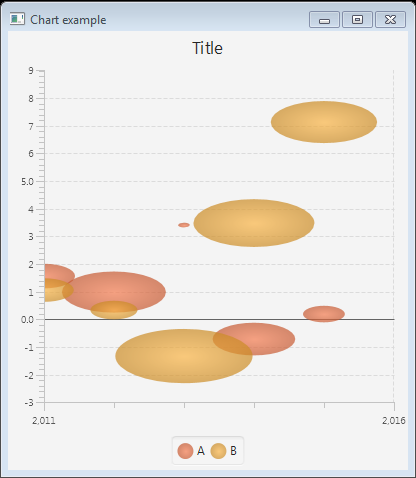JavaFX 气泡图
2018-03-13 00:22 更新
JavaFX教程 - JavaFX气泡图
气泡图是一个双轴图表,为一系列数据点绘制气泡。
创建气泡图
要创建气泡图,我们创建BubbleChart类,定义水平和垂直轴,并使用添加一个或多个数据系列XYChart.Data类。
/*
* Copyright (c) 2011, 2012 Oracle and/or its affiliates.
* All rights reserved. Use is subject to license terms.
*
* This file is available and licensed under the following license:
*
* Redistribution and use in source and binary forms, with or without
* modification, are permitted provided that the following conditions
* are met:
*
* - Redistributions of source code must retain the above copyright
* notice, this list of conditions and the following disclaimer.
* - Redistributions in binary form must reproduce the above copyright
* notice, this list of conditions and the following disclaimer in
* the documentation and/or other materials provided with the distribution.
* - Neither the name of Oracle nor the names of its
* contributors may be used to endorse or promote products derived
* from this software without specific prior written permission.
*
* THIS SOFTWARE IS PROVIDED BY THE COPYRIGHT HOLDERS AND CONTRIBUTORS
* "AS IS" AND ANY EXPRESS OR IMPLIED WARRANTIES, INCLUDING, BUT NOT
* LIMITED TO, THE IMPLIED WARRANTIES OF MERCHANTABILITY AND FITNESS FOR
* A PARTICULAR PURPOSE ARE DISCLAIMED. IN NO EVENT SHALL THE COPYRIGHT
* OWNER OR CONTRIBUTORS BE LIABLE FOR ANY DIRECT, INDIRECT, INCIDENTAL,
* SPECIAL, EXEMPLARY, OR CONSEQUENTIAL DAMAGES (INCLUDING, BUT NOT
* LIMITED TO, PROCUREMENT OF SUBSTITUTE GOODS OR SERVICES; LOSS OF USE,
* DATA, OR PROFITS; OR BUSINESS INTERRUPTION) HOWEVER CAUSED AND ON ANY
* THEORY OF LIABILITY, WHETHER IN CONTRACT, STRICT LIABILITY, OR TORT
* (INCLUDING NEGLIGENCE OR OTHERWISE) ARISING IN ANY WAY OUT OF THE USE
* OF THIS SOFTWARE, EVEN IF ADVISED OF THE POSSIBILITY OF SUCH DAMAGE.
*/
//package bubblechartsample;
import javafx.application.Application;
import javafx.scene.Scene;
import javafx.scene.chart.BubbleChart;
import javafx.scene.chart.NumberAxis;
import javafx.scene.chart.XYChart;
import javafx.scene.paint.Color;
import javafx.stage.Stage;
public class Main extends Application {
@Override public void start(Stage stage) {
stage.setTitle("Bubble Chart Sample");
final NumberAxis xAxis = new NumberAxis(1, 53, 4);
final NumberAxis yAxis = new NumberAxis(0, 80, 10);
final BubbleChart<Number,Number> blc =
new BubbleChart<Number,Number>(xAxis,yAxis);
xAxis.setLabel("Week");
xAxis.setTickLabelFill(Color.CHOCOLATE);
xAxis.setMinorTickCount(4);
yAxis.setLabel("Product Budget");
yAxis.setTickLabelFill(Color.CHOCOLATE);
yAxis.setTickLabelGap(10);
yAxis.setTickLabelFormatter(
new NumberAxis.DefaultFormatter(yAxis,"$ ",null)
);
blc.setTitle("Budget Monitoring");
XYChart.Series series1 = new XYChart.Series();
series1.setName("Product 1");
series1.getData().add(new XYChart.Data(3, 35, 2));
series1.getData().add(new XYChart.Data(12, 60, 1.8));
series1.getData().add(new XYChart.Data(15, 15, 7));
series1.getData().add(new XYChart.Data(22, 30, 2.5));
series1.getData().add(new XYChart.Data(28, 20, 1));
series1.getData().add(new XYChart.Data(35, 41, 5.5));
series1.getData().add(new XYChart.Data(42, 17, 9));
series1.getData().add(new XYChart.Data(49, 30, 1.8));
XYChart.Series series2 = new XYChart.Series();
series2.setName("Product 2");
series2.getData().add(new XYChart.Data(8, 15, 2));
series2.getData().add(new XYChart.Data(13, 23, 1));
series2.getData().add(new XYChart.Data(15, 45, 3));
series2.getData().add(new XYChart.Data(24, 30, 4.5));
series2.getData().add(new XYChart.Data(38, 78, 1));
series2.getData().add(new XYChart.Data(40, 41, 7.5));
series2.getData().add(new XYChart.Data(45, 57, 2));
series2.getData().add(new XYChart.Data(47, 23, 3.8));
Scene scene = new Scene(blc);
blc.getData().addAll(series1, series2);
//scene.getStylesheets().add("bubblechartsample/Chart.css");
stage.setScene(scene);
stage.show();
}
public static void main(String[] args) {
launch(args);
}
}
NumberAxis.DefaultFormatter类将向指定轴的标记添加前缀和后缀。
yAxis.setTickLabelFormatter(new NumberAxis.DefaultFormatter(yAxis,"$ ",null));
以下代码行指定了刻度标签的CHOCOLATE颜色。
xAxis.setTickLabelFill(Color.CHOCOLATE); yAxis.setTickLabelFill(Color.CHOCOLATE);
上面的代码生成以下结果。
例子
import javafx.application.Application;
import javafx.collections.FXCollections;
import javafx.collections.ObservableList;
import javafx.scene.Scene;
import javafx.scene.chart.BubbleChart;
import javafx.scene.chart.NumberAxis;
import javafx.scene.chart.XYChart;
import javafx.scene.chart.XYChart.Series;
import javafx.scene.layout.StackPane;
import javafx.stage.Stage;
public class Main extends Application {
public static void main(String[] args) {
launch(args);
}
@Override
public void start(Stage primaryStage) {
NumberAxis xAxis = new NumberAxis();
NumberAxis yAxis = new NumberAxis();
xAxis.setAutoRanging(false);
xAxis.setLowerBound(2011);
xAxis.setUpperBound(2016);
BubbleChart bubbleChart = new BubbleChart(xAxis, yAxis);
bubbleChart.setData(getChartData());
bubbleChart.setTitle("Title");
primaryStage.setTitle("Chart example");
StackPane root = new StackPane();
root.getChildren().add(bubbleChart);
primaryStage.setScene(new Scene(root, 400, 250));
primaryStage.show();
}
private ObservableList<XYChart.Series<Integer, Double>> getChartData() {
double aValue = 1.56;
double bValue = 1.06;
ObservableList<XYChart.Series<Integer, Double>> answer = FXCollections.observableArrayList();
Series<Integer, Double> aSeries = new Series<Integer, Double>();
Series<Integer, Double> bSeries = new Series<Integer, Double>();
aSeries.setName("A");
bSeries.setName("B");
for (int i = 2011; i < 2016; i++) {
double diff = Math.random();
aSeries.getData().add(new XYChart.Data(i, aValue, diff));
aValue = aValue + 10*diff - 5;
diff = Math.random();
bSeries.getData().add(new XYChart.Data(i, bValue, diff));
bValue = bValue + 10*diff - 5;
diff = Math.random();
}
answer.addAll(aSeries, bSeries);
return answer;
}
}
上面的代码生成以下结果。

以上内容是否对您有帮助:





更多建议: